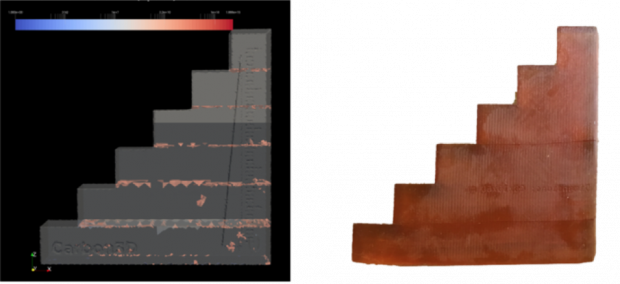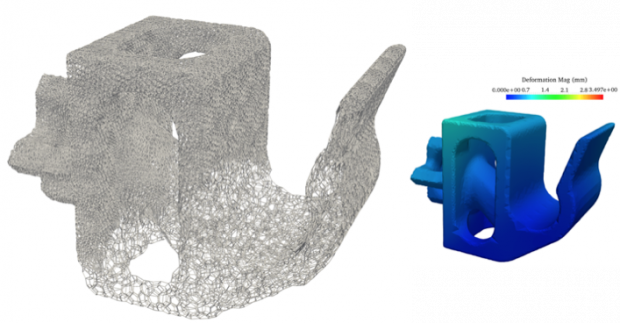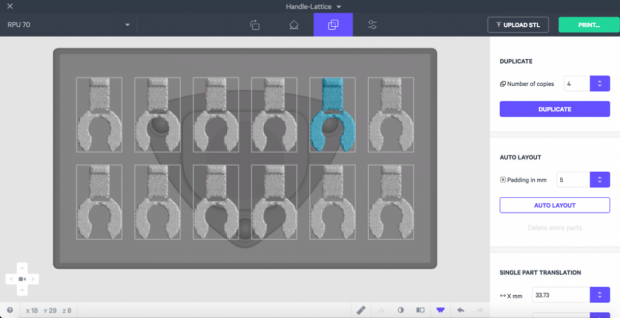Carbon 3D Print Software Updated

Carbon 3D print software allows designers to simulate stress buildup during 3D printing, which can help them predict potential warping and/or cracking challenges with part production. Areas where stress has built up are shown here in red. Image courtesy of Carbon Inc.
Latest News
January 10, 2018
Silicon Valley-based 3D manufacturing company Carbon Inc. has announced a new version of its 3D printing software for its line of Digital Light Synthesis (DLS) 3D printers. The new release of the eponymously named Carbon software expands its tools by enabling users to design, engineer and make polymeric parts using the company’s DLS technology and resins, the company says.
Carbon says that, with this software release, it now offers a variety of tools that enable users to print parts easily and successfully the first time, optimize supports for material usage as well as minimize post-processing. These new software tools, the company adds, are backed by cloud-based FEA (finite element analysis) techniques that simulate the forces of DLS.
 Carbon 3D print software allows designers to simulate stress buildup during 3D printing, which can help them predict potential warping and/or cracking challenges with part production. Areas where stress has built up are shown here in red. Image courtesy of Carbon Inc.
Carbon 3D print software allows designers to simulate stress buildup during 3D printing, which can help them predict potential warping and/or cracking challenges with part production. Areas where stress has built up are shown here in red. Image courtesy of Carbon Inc.Carbon cites the following as among the key features of its 3D print software:
- Software-controlled chemical reaction of the printing process: Complex physics and chemistry models are built into Carbon software, so the printer knows, for example, how to print complex fluidic parts versus a mid-sole for an Adidas shoe. This software-driven intelligence helps users iterate rapidly from design to prototyping to production, the company says.
- Algorithmic design: Designers can create internal lattice structures as well as add aesthetic and functional textures.
- Printer profiles: Carbon printers come with multiple printer profiles, each of which is optimized for production speed and repeatability.
- Provenance: For most users, it is critical to know the full lineage of a produced part. With Carbon, everything is digitally traceable, down to a unique ID that can automatically be engraved or embossed on a part. This unique ID can be used to identify the digital historical record of the part, including the specific printer, resin and even post-processing protocols that were involved in making that part.
- Fleet management: For final production to happen at scale, manufacturers need an easy way to install and manage multiple printers. From real-time dashboards to aggregate data and reports, to an API (application programming interface) that enables integration with existing business systems, Carbon’s printer software platform supports fleet management of connected 3D printing and manufacturing units that it calls SpeedCell.
 To fix a deformation problem, Carbon software can automatically generate the appropriate lattice based on the desired performance. Image courtesy of Carbon Inc.
To fix a deformation problem, Carbon software can automatically generate the appropriate lattice based on the desired performance. Image courtesy of Carbon Inc.Highlights of this latest software update as described by the company include:
- Advanced auto supports: This cloud-powered feature analyzes users’ parts and helps ensure successful printing in the first iteration. It also helps users understand where a specific part may need more support, aiding in the design of a manual support strategy.
- New fence supports: Fence supports can be used to support edges so they print with precision, minimize material usage and produce parts with minimal support artifacts.
- Fast and secure simulations: Carbon uses a secure, cloud-based computing architecture that substantially speeds up simulations from days to hours.
 Shown here is Carbon’s browser-based software interface being used to lay out a 3D print project. Image courtesy of Carbon Inc.
Shown here is Carbon’s browser-based software interface being used to lay out a 3D print project. Image courtesy of Carbon Inc.“Carbon is often recognized for its innovations in hardware and materials science, but our software is what enables all of these pieces to work together seamlessly,” said Roy Goldman, director of software at Carbon, in the press announcement. “Carbon’s software creates a digital canvas on which every cubic millimeter of a part can be designed, controlled and optimized before it’s printed. ... These new FEA-backed automated support tools are the first of their kind and take our software to a whole new level.”
To learn more about Carbon software, click here.
For more information on Carbon’s line of 3D printers, go here.
Learn more about Carbon’s DLS (Digital Light Synthesis) process here.
Go here to read about Carbon materials.
Read how Incase and Carbon are partnering to improve device protection solutions.
See why DE‘s Editors selected the Carbon software update as their Pick of the Week.
Sources: Press materials received from the company and additional information gleaned from the company’s website.
Subscribe to our FREE magazine, FREE email newsletters or both!
Latest News
About the Author
Anthony J. Lockwood is Digital Engineering’s founding editor. He is now retired. Contact him via [email protected].
Follow DE





